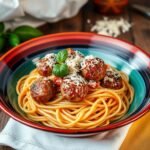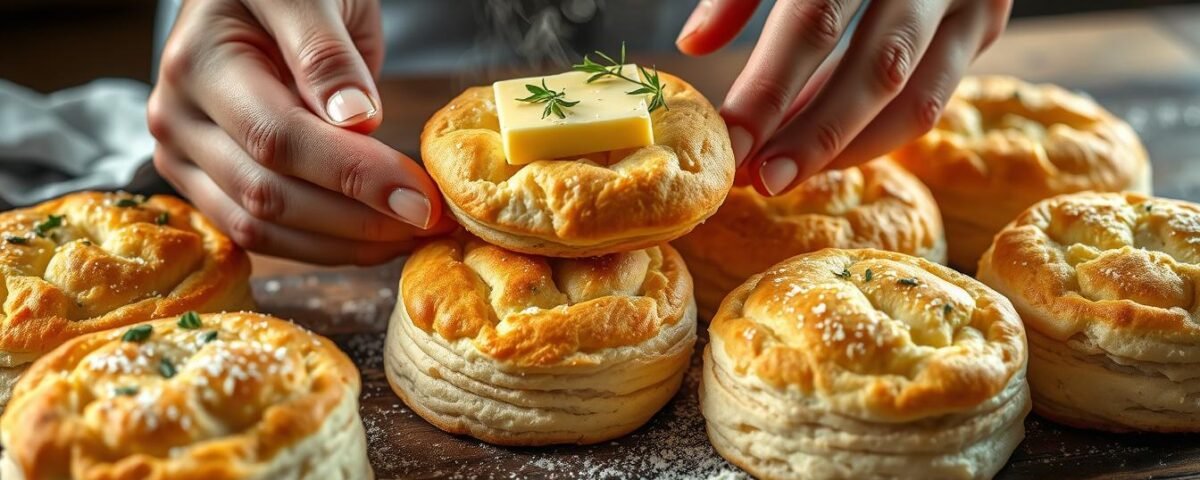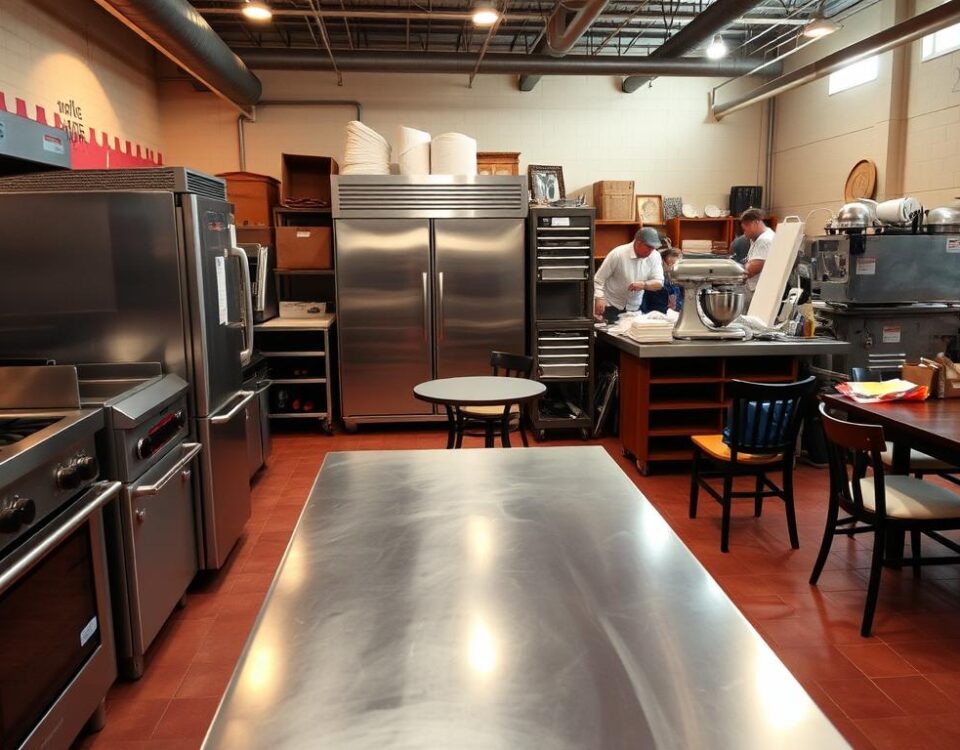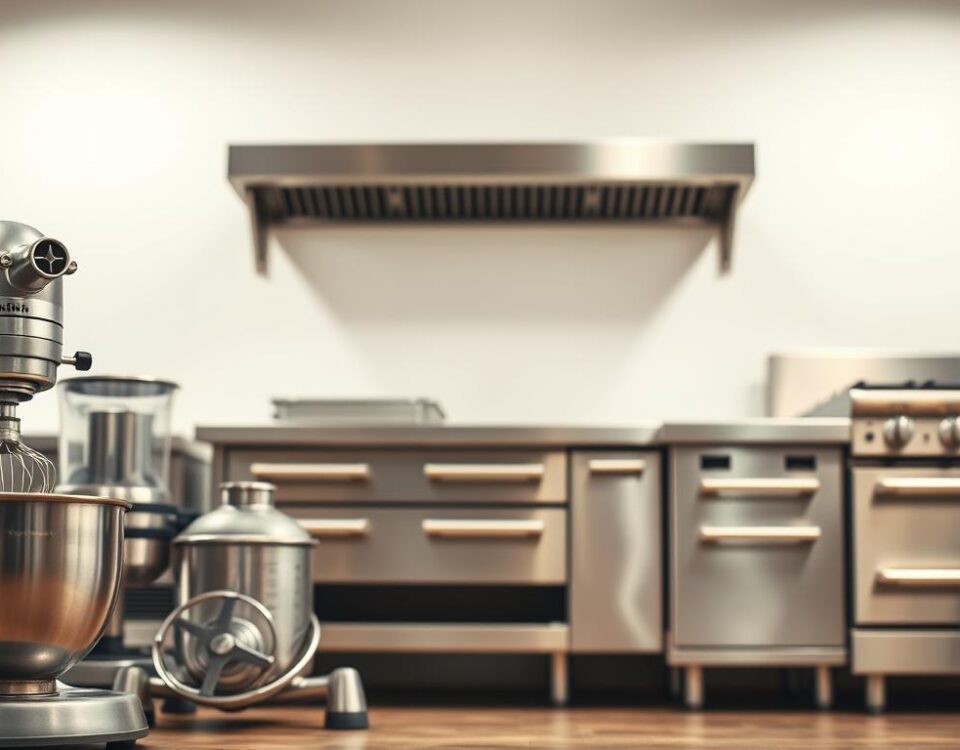
4 Game-Changing Ways to Serve Spaghetti and Meatballs
February 6, 2025
7 Pro Chef Tips for Perfectly Juicy & Flavorful Fajitas!
February 6, 2025Imagine this: It’s a lazy Sunday morning. The smell of freshly baked biscuits fills the air. My first time making homemade biscuits was on a cool fall afternoon. I had a recipe from my grandma’s old cookbook. I doubted something so simple could taste so amazing. But when I saw those golden biscuits come out of the oven, I was mesmerized.
This guide will show you, step by step, how to make amazing flaky and buttery biscuits. You don’t have to be scared of baking. This biscuit recipe is all about keeping things easy and using good ingredients.
Key Takeaways
- Preheat your oven to 400 degrees Fahrenheit for at least 30 minutes.
- The recipe yields 10-12 biscuits using a 3-inch cutter.
- Use 12 tablespoons (1 ½ sticks) of frozen unsalted butter.
- Prepare the dough using 2 ¼ cups of all-purpose flour.
- Incorporate 2 and ½ teaspoons of baking powder for lifting.
- Avoid twisting the cutter to ensure biscuits rise properly.
- Total preparation and baking time: 35 minutes.
Why I Love Flaky Buttery Biscuits
Making biscuits is more than just cooking for me; it’s a family tradition. It comes from my grandma, to my mom, and now to me. It’s filled with memories and love. These “cathead” biscuits are big and fluffy. They remind me of family times and cozy mornings.
A Comfort Food Tradition
Mixing flour with cold butter brings back special memories. I’ve learned that White Lily flour works best, but any quality flour does the job. This tradition is simple and takes about 45 minutes. These fluffy biscuits have layers made with a special technique. It’s different from how my grandma made biscuits.
Perfect for Any Meal
These biscuits are perfect for any time of day. They can be for breakfast with jam, dinner, or a snack. They’re always a hit at gatherings, bringing people together. Sharing these with loved ones makes baking worth it.
| Nutritional Facts per Serving (1 Biscuit) | Quantity |
|---|---|
| Calories | 211 |
| Total Fat | 9g |
| Saturated Fat | 5.5g |
| Cholesterol | 23.4mg |
| Sodium | 279.4mg |
| Carbohydrate | 29.6g |
| Dietary Fiber | 1g |
| Total Sugars | 2.9g |
| Protein | 4.2g |
Essential Ingredients for Biscuit Perfection
Making amazing homemade biscuits means knowing the right ingredients. These help create that fluffy texture and tasty flavor we all love. Let’s explore what you need for a great batch of biscuits.
All-Purpose Flour: The Foundation
All-purpose flour is a must for biscuits. I use 2 cups (260g), choosing softer brands like White Lilly or Bob’s Red Mill. They have less protein, making biscuits tender and airy.
Butter: The Key to Flakiness
For flakiness, use 6 tablespoons (85g) of cold European-style salted butter. It needs to stay cold until baking time. That way, it makes steam, layers, and air pockets, making biscuits super fluffy.
Baking Powder vs. Baking Soda
Leaveners like baking powder and baking soda are key. I use 5 teaspoons of baking powder for rise and texture. And 1/4 teaspoon of baking soda for browning and flavor balance. Adding 1 tablespoon of sugar and 1 teaspoon of *fine sea salt* makes them taste great. Use less salt if your butter is salted.
| Ingredient | Quantity | Purpose |
|---|---|---|
| All-Purpose Flour | 2 cups (260g) | Provides structure |
| Butter | 6 tablespoons (85g) cold | Creates flakiness and layers |
| Baking Powder | 5 teaspoons | Leavening agent for rise |
| Baking Soda | 1/4 teaspoon | Aids in browning |
| Sugar | 1 tablespoon | Flavor |
| Salt | 1 teaspoon | Enhances flavor |
My Secret to Preparing the Dough
Making the perfect dough for buttery biscuits requires precision and patience. I’ll share my best tips for amazing homemade biscuits with an easy biscuit recipe. These tips are great for both new and experienced bakers.
Measuring Ingredients Accurately
Accurate measurements are crucial for great buttery biscuits. Let’s look at what you’ll need:
- 2 1/2 cups all-purpose flour
- 2 tablespoons baking powder
- 1 teaspoon sugar
- 1 teaspoon salt
- 8 tablespoons cold unsalted butter
- 1 cup buttermilk
Don’t guess the amount; use measuring cups and spoons. Right amounts ensure your biscuits taste and feel perfect.
Mixing Techniques: Avoid Overworking
How you mix impacts your biscuits. Avoid overworking the dough to keep biscuits tender.
Here’s how:
- Pulse the butter 6 to 7 times in the food processor with the dry ingredients.
- Gently combine the dough, folding and rolling it about 6 times.
This will make your biscuits tender and flaky, perfect for any meal.
Chilling the Dough: Why It Matters
Chilling the dough is important. It helps the butter stay firm, making the biscuits flaky.
Cut the dough into shapes and freeze for 15 minutes before baking. This step ensures a better texture.
| Ingredient | Measurement |
|---|---|
| All-purpose flour | 2 1/2 cups |
| Baking powder | 2 tablespoons |
| Sugar | 1 teaspoon |
| Salt | 1 teaspoon |
| Cold unsalted butter | 8 tablespoons |
| Buttermilk | 1 cup |
| Total calories per biscuit | 247 kcal |
Use these steps to improve your homemade biscuits. Enjoy your baking!
Rolling and Cutting Biscuits Like a Pro
Rolling biscuit dough seems easy, but following the right tips can make a big difference. The right start is crucial for any biscuit recipe to work.
Tips for Rolling Out the Dough
Remember these steps when rolling your dough:
- Lightly flour your surface: This stops the dough from sticking without using too much flour.
- Work quickly: Your hands’ warmth can melt the butter, making the biscuits less flaky.
- Maintain an even thickness: The dough should be about ½ inch thick for even biscuits.
Using a Biscuit Cutter vs. a Glass
What you use to cut the biscuits can change their texture and how they rise. Here are the main differences:
| Tool | Result | Benefits | Drawbacks |
|---|---|---|---|
| Biscuit Cutter | Even rise | Sharp edges cut cleanly, less dough compression | May need to buy one |
| Glass | Variable rise | Easy to find at home, no extra cost | Edges might get squished, affecting the rise |
Choosing between a biscuit cutter and a glass really depends on what you have and how perfect you want your biscuits to look.
Baking Biscuits to Golden Brown Perfection
Making homemade biscuits that are flaky and golden brown requires precision. Whether for breakfast or dinner, it’s crucial to keep an accurate oven temperature and preheat it well. We’ll explore why these steps are important for biscuit-making success.
Oven Temperature: Why Precision Counts
The right oven temperature is key to baking excellent homemade biscuits. For biscuits that are evenly golden brown, heating your oven to 450 degrees Fahrenheit is vital. This high heat helps biscuits rise quickly, making them light and airy. Here are some temperature tips for perfect biscuits:
| Recipe Component | Recommended Temperature | Baking Time | Outcome |
|---|---|---|---|
| Classic Biscuits | 450°F | 10-14 minutes | Golden Brown Biscuits |
| Drop Biscuits | 450°F | Approximately 16 minutes | Golden Brown Biscuits |
Remember to space your biscuits about one inch apart. This ensures they cook evenly and expand properly.
The Importance of Preheating
Preheating your oven is a step you shouldn’t skip when baking biscuits. It ensures biscuits start cooking right away, helping them rise evenly. Always preheat your oven to 450 degrees Fahrenheit 15 minutes before you start. This keeps the oven temperature steady, essential for achieving flaky biscuits.
By accurately setting your oven temperature and preheating, you’re set to make flaky, delicious homemade biscuits. These biscuits will not only look great but taste amazing too.
Flavor Enhancements for My Biscuits
Making biscuits isn’t just about the basics. It’s about discovering endless tasty twists for your recipes. Adding flavor to homemade biscuits is easy, whether you like them savory or sweet.
Adding Herbs and Cheese
When you mix savory items like herbs and cheese into your biscuits, they taste amazing. Herbs such as rosemary, thyme, and chives make them fresh. Cheese like cheddar or parmesan adds richness.
The trick is to mix these add-ins gently to keep the dough light and flaky. Add-ins should be 1/3 of the dough’s volume. This way, the biscuits stay flaky and delicious.
Sweet Variations: Honey and Jam
If you love sweet flavors, try adding honey or jams. Drizzling honey over dough before baking makes it sweet and caramelized. Mixing your favorite jam, like raspberry or apricot, gives beautiful swirls and flavors.
To find more tips on perfecting your biscuits and other favorite recipes, visit these chef-approved tips.
Common Mistakes in Biscuit-Making
Many bakers often make a few common biscuit mistakes. Knowing what these mistakes are is crucial for making those dreamy, fluffy biscuits.
Overmixing the Dough
One big tip for biscuit baking is not to overmix. Too much mixing makes the dough tough and the biscuits dense. Instead, mixing it just 15 times helps get the best light and fluffy texture.
Skipping the Chill
Not chilling the dough is another mistake. You should chill the butter and flour mix for at least 10 minutes. This keeps the butter cold, which is important for creating flaky layers. A cold start helps your biscuits rise high and not turn out flat.
| Common Biscuit Mistakes | Solutions |
|---|---|
| Overmixing the Dough | Stir the dough exactly 15 times to maintain the perfect texture. |
| Skipping the Chill | Refrigerate the butter-flour mixture for at least 10 minutes before baking. |
Remember these biscuit baking tips to steer clear of the usual biscuit-blunders. This way, your biscuits will always turn out light and tasty.
Best Tools for Biscuit Making
For great homemade biscuits, you need the right tools. These tools make sure your biscuits are flaky, buttery, and delicious.
Essential Kitchen Equipment
Some equipment is a must for making biscuits:
- Pastry Cutter: Great for blending butter into flour, ensuring the butter blends well without melting.
- Biscuit Cutter: Creates biscuits that are all the same size. A set with different sizes works best.
- Baking Pan: A good, non-stick baking pan helps bake evenly and makes removing biscuits easier.
Must-Have Tools for Beginners
Starting your biscuit-making journey? These tools make it easier and fun:
- Measuring Cups and Spoons: Baking needs precision, so dependable measuring tools are key.
- Rolling Pin: It helps get the dough thickness just right. Choose one with adjustable rings.
- Pastry Brush: A brush for applying melted butter on biscuits before baking is useful.
Getting these baking tools can really improve your biscuit-making. They make a big difference in the quality of your biscuits. These tools will help whether you’re new to baking or have been doing it for years.
Serving Flaky Buttery Biscuits
Biscuits bring joy due to their flexibility and the vast choices of sides to boost their taste. Let’s look into some tasty biscuit sides and unique ways to enjoy these buttery gems.
Delicious Accompaniments
The possibilities for biscuit sides are endless. Here are some top picks:
- Jams and Preserves: Try Southern biscuits with sweet spreads like strawberry jam, apricot preserves, or fig butter.
- Gravies: A warm biscuit covered in sausage gravy or creamy chicken gravy is the ultimate comfort food.
- Honey and Butter: For a sweet and savory mix, pour honey over a buttered biscuit.
- Cream Cheese and Smoked Salmon: Spread some cream cheese on, then add smoked salmon and fresh dill for elegance.
Creative Serving Ideas
Try these fun ideas to make your biscuit meals even better:
- Breakfast Sandwiches: Put scrambled eggs, bacon, and cheese between a biscuit for a filling breakfast.
- Mini Biscuit Burgers: Use small biscuits as buns for mini burgers, offering a new take on a classic.
- Southern Benedict: A biscuit instead of an English muffin gives a Southern flavor to eggs Benedict at brunch.
- Dessert Biscuits: Biscuits with whipped cream and fresh berries make for a tasty shortcake dessert.
| Prep Time | Cook Time | Chilling Time | Total Time |
|---|---|---|---|
| 30 minutes | 22 minutes | 15 minutes | 1 hour 7 minutes |
| Serving Size | Calories | Total Fat | Saturated Fat |
| 1 biscuit | 355 kcal | 19g (29% DV) | 12g (75% DV) |
| Cholesterol | Sodium | Potassium | Carbs |
| 50mg (17% DV) | 550mg (24% DV) | 409mg (12% DV) | 41g (14% DV) |
| Fiber | Sugar | Protein | Vitamin A |
| 1g (4% DV) | 3g (3% DV) | 6g (12% DV) | 593 IU (12% DV) |
| Calcium | Iron | ||
| 185mg (19% DV) | 2mg (11% DV) |
With these serving tips and tasty sides, each bite of these Southern biscuits will surely make you smile. Enjoy!
Storing Leftover Biscuits
Storing biscuits right keeps them as good as when they first came out of the oven. I’ll share the top ways to keep baked goods fresh. Plus, find out how to reheat biscuits to make them taste like they’re fresh out of the oven again.
How to Keep Them Fresh
To avoid dry or stale biscuits, it’s important to store them correctly. Keep them in an airtight container in the fridge to stay fresh for up to 5 days. For keeping them longer, first wrap them in plastic wrap, then in tin foil, and freeze. They’ll last up to 3 months this way. Remember, biscuits made with perishable ingredients should be refrigerated.
- Room Temperature: Biscuits last up to 2 days at room temperature in an airtight container.
- Refrigeration: They can last about 1 week in the fridge.
- Freezing: Wrapped biscuits stay fresh for up to 3 months in the freezer. Use vacuum-sealed bags for best freshness.
Storing biscuit dough in the fridge means you can have fresh biscuits anytime. Just separate the dough into portions and freeze for about 3 hours. Then, store them in airtight bags.
Reheating Tips for Best Results
Reheating biscuits the right way can make them taste wonderful again. Here are some tips for warming up biscuits:
To reheat, warm your oven to 350°F. Put biscuits on a baking sheet and cover with foil. Bake for 6 to 8 minutes with foil on, then 4 to 6 minutes without the foil. This way they get thoroughly heated without drying out.
Another great method is using a flat top grill for biscuit halves. Just butter the cut side and toast until golden. This brings back their fresh taste. Or, make biscuit croutons by baking old biscuits at 350°F for about 10 to 12 minutes.
With these professional storing and reheating tricks, you can enjoy delicious, flaky, and buttery biscuits days after making them.
Troubleshooting Biscuit Problems
Baking homemade biscuits can sometimes go wrong. Knowing common problems and how to fix them helps get perfect biscuits.
What to Do with Tough Biscuits
Tough biscuits often happen if you work the dough too much. To avoid this, mix just until everything is combined. Overmixing makes the dough tough. Also, use cold butter—grate a frozen stick of butter for the best dough.
Don’t twist the cutter when shaping biscuits. Twisting seals the edges, stopping them from rising right.
The flour type is also key. All-purpose flour makes biscuits tough. For tender biscuits, use self-rising flour, like White Lily, which has less protein. Fresh ingredients, like flour and buttermilk, are crucial. Overkneading and not chilling the dough also make biscuits tough.
Fixing Spreading Issues
If biscuits spread too much and don’t rise, a few things could be wrong. Baking powder or soda might be old. Always check if they’re still good. Also, don’t cut biscuits with a glass or twist the cutter.
An oven at 450°F is best for biscuit rise. Keep the dough’s fat cold; chill cut-out biscuits for 10-20 minutes before baking. Also, put biscuits close together on the tray for support while baking.
- Test leavening agents before use.
- Freeze or refrigerate biscuits before baking.
- Ensure proper spacing on the baking sheet.
- Use appropriate cutting tools and techniques.
| Problem | Possible Cause | Solution |
|---|---|---|
| Tough Biscuits | Overworked dough, warm butter, high-protein flour | Mix until combined, use grated frozen butter, switch to self-rising flour like White Lily |
| Spreading Biscuits | Expired leavening agents, twisting while cutting, insufficient dough chilling | Test baking powder/soda, punch straight down when cutting, chill biscuits before baking |
My Favorite Biscuit Recipes
I love trying out new biscuit recipes. My top picks are classic buttermilk biscuits and sweet potato biscuits. They’re ideal for any event.
Classic Buttermilk Biscuits
Making buttermilk biscuits is easy and the outcome is flaky biscuits. Here’s my method:
- Ingredients:
- 3 cups all-purpose flour
- 3 tablespoons sugar
- 1/2 teaspoon salt
- 4 teaspoons baking powder
- 1/2 teaspoon cream of tartar (optional)
- 3/4 cup cold butter
- 1 egg (optional)
- 1 cup whole milk or buttermilk
- Instructions:
- Start by heating your oven to 450°F (232°C).
- Mix together the flour, sugar, salt, baking powder, and if you’re using it, the cream of tartar.
- Then cut the cold butter in until it looks like coarse crumbs.
- If you’re using an egg, beat it now and add with the milk or buttermilk, just until it’s moist.
- Put dough on a surface dusted with flour and gently knead it.
- Roll out dough to about 3/4 inch thick and use a biscuit cutter.
- Place them on a baking sheet without greasing it and bake for 10 to 15 minutes, until they’re golden.
Flaky Sweet Potato Biscuits
I sometimes make sweet potato biscuits for a change. They’re moist, flavorful, and full of good stuff.
- Ingredients:
- 2 cups all-purpose flour
- 1 tablespoon baking powder
- 1/2 teaspoon baking soda
- 1/2 teaspoon salt
- 1/2 cup cold butter
- 1 cup mashed sweet potatoes
- 1/2 cup buttermilk
- Instructions:
- Heat your oven to 450°F (232°C) to start.
- Mix the flour, baking powder, baking soda, and salt in a big bowl.
- Cut the butter in until the mix looks like coarse crumbs.
- Add the sweet potatoes and buttermilk and stir just until combined.
- Put dough on a floured surface, knead gently, then roll out to 1/2 inch thick.
- Cut with a biscuit cutter and place biscuits on a baking sheet without greasing it.
- Bake for about 10 to 12 minutes, until they start to brown on top.
These sweet potato biscuits are sweet and have a lovely orange color. They make your table more vibrant.
Final Thoughts on Biscuit Perfection
Making biscuits at home mixes art with science. It’s a joy to create 24 delicious biscuits by blending flour, frozen butter, and buttermilk. Then, you bake them at 350 degrees until golden. Managing the oven’s heat and choosing the right biscuit cutter are key steps.
Embracing the Biscuit-Baking Journey
Baking biscuits is a journey that’s definitely worth it. From mixing flour and butter to rolling the dough just right, it’s full of steps to learn. Chefs like Carla Hall and Joanna Gaines show that making the perfect biscuit takes love and effort. The right chilling time, oven temperature, and maybe some herbs or sweets can make your biscuits amazing.
Share Your Biscuit Creations With Me
Don’t keep your biscuit adventures to yourself, share them! I invite you to try new flavors and use the baking tips we talked about. When you’ve nailed your biscuit recipe, share it with us. Post pictures, recipes, and celebrate the deliciousness of biscuits together. Let’s build a community that loves and appreciates biscuit making.
FAQ
What are the essential ingredients for making Flaky Buttery Biscuits?
The essential ingredients include all-purpose flour, butter, baking powder, and baking soda. These ingredients are key for that perfect flaky and buttery texture.
Why is measuring ingredients accurately important in biscuit-making?
Accurate measurements are crucial for the right texture and taste. Too much flour results in dry biscuits. Too little and they become too wet and dense.
What is the best way to mix biscuit dough?
Don’t overwork the dough. Mix ingredients until just combined. This keeps your biscuits light and fluffy.
Why should I chill the dough before baking biscuits?
Chilling the dough solidifies the butter, creating flakier layers. It also hinders spreading, ensuring tall and well-structured biscuits.
What’s the best technique for rolling out biscuit dough?
Roll dough gently with a light touch to maintain air pockets for flakiness. Use a bit of flour to stop sticking.
Should I use a biscuit cutter or a glass to cut my biscuits?
Prefer a biscuit cutter for an even rise. A glass might seal edges, hindering proper rising.
What oven temperature is best for baking biscuits?
Bake at high heat, 450°F, for quick rising, golden crusts, while keeping the inside tender and flaky.
Why is preheating the oven important?
Preheating ensures biscuits bake immediately for even cooking and perfect rising. Not preheating can lead to unevenly baked goods.
Can I add flavors to my biscuits?
Yes! Enhance biscuits with herbs, cheese, honey, or jam for variety.
What are common mistakes in biscuit-making?
Common pitfalls include overmixing dough, making biscuits tough, and not chilling dough, causing them to flatten and spread out.
What tools are essential for making biscuits?
Essential tools include a mixing bowl, pastry cutter, rolling pin, and biscuit cutter for consistent results.
How should I serve Flaky Buttery Biscuits?
Biscuits go well with butter, jam, honey, or in savory dishes. They’re a delightful part of Southern meals.
How do I store leftover biscuits?
Keep biscuits in an airtight container at room temperature for two days or freeze them. Reheat for freshness.
How do I fix tough biscuits?
To fix tough biscuits, mix dough just until combined next time. More butter may also help the texture.
What can I do if my biscuits spread too much?
Chill dough well, use a proper biscuit cutter, and ensure your baking powder is fresh for less spreading.
What are some of your favorite biscuit recipes?
Favorites include Classic Buttermilk Biscuits and Flaky Sweet Potato Biscuits. Both recipes are easy and tasty.
How did you perfect your flaky biscuit recipe?
Perfecting flaky biscuits involved lots of trials, focusing on measurements, gentle mixing, and chilling dough. Experiment to find what works for you!



